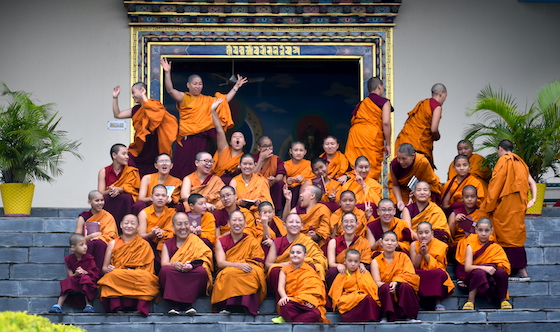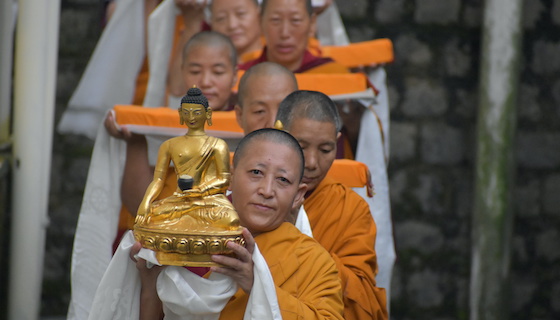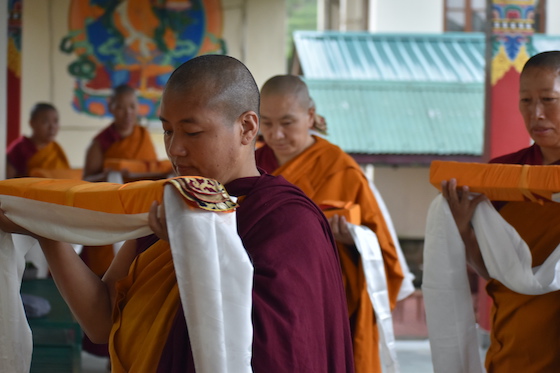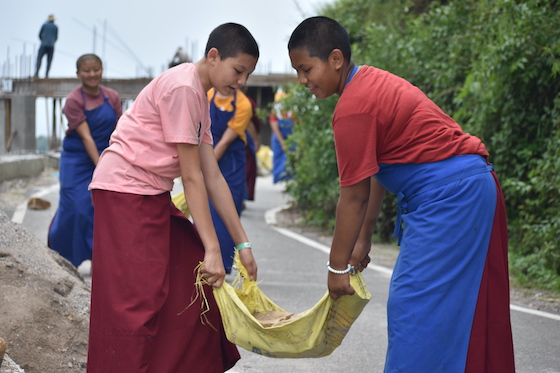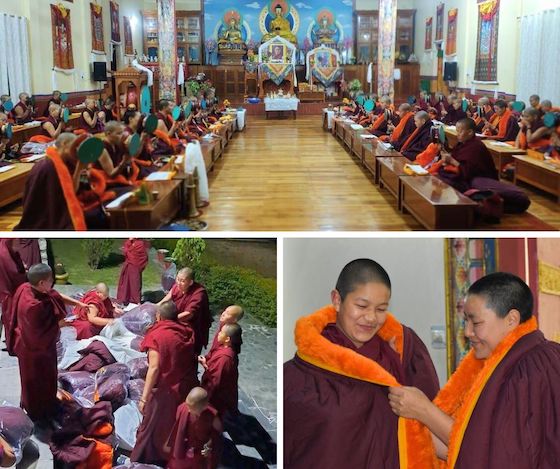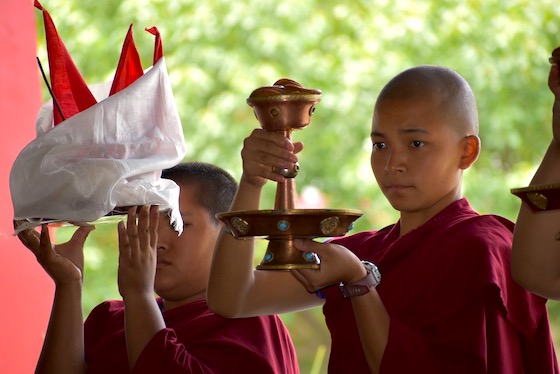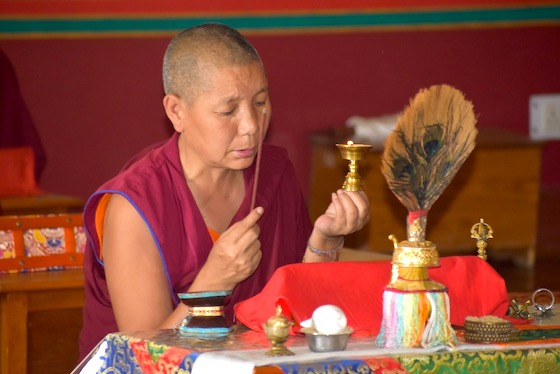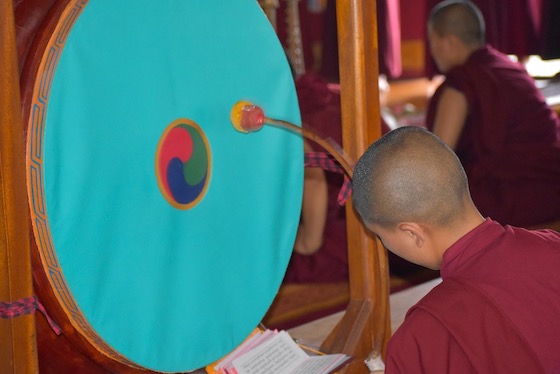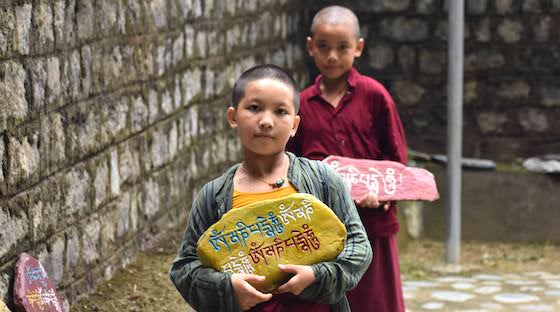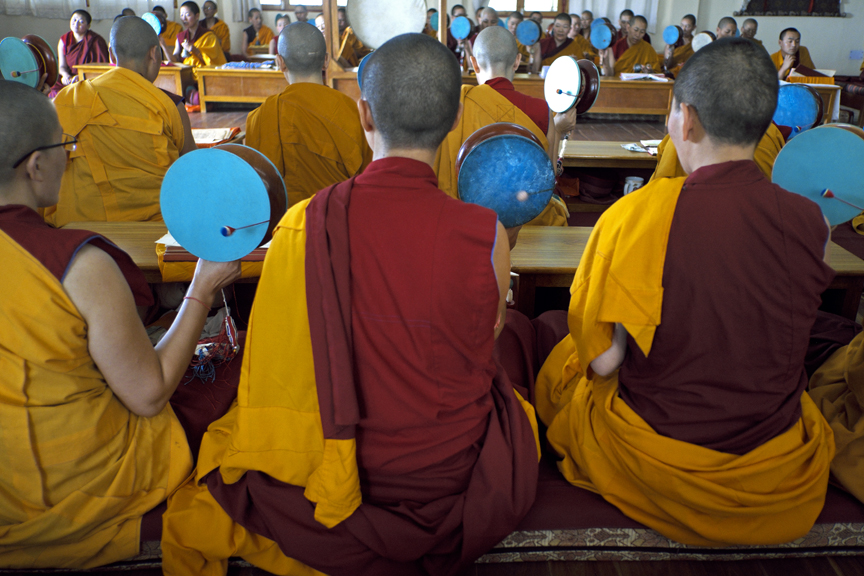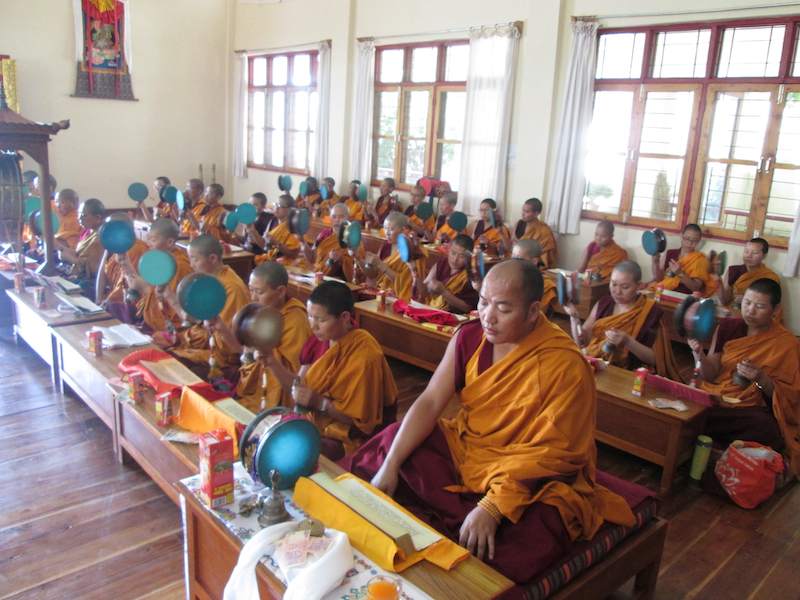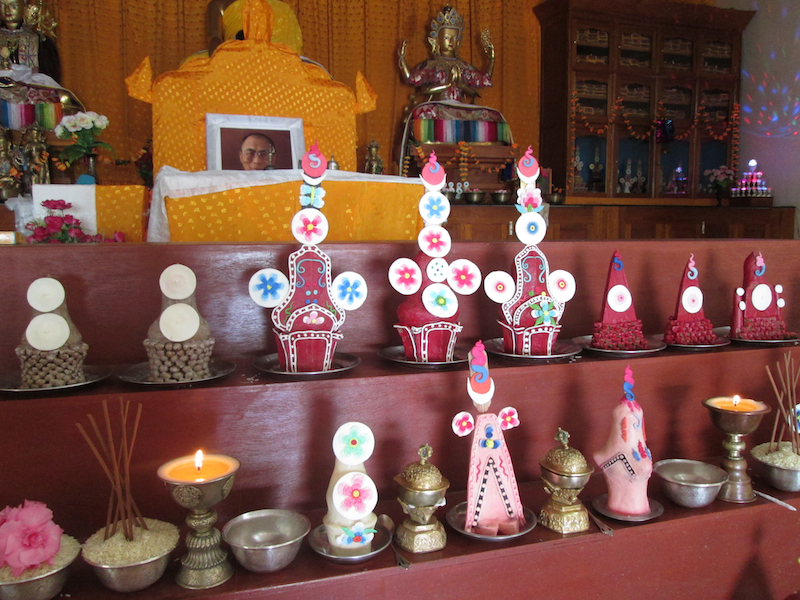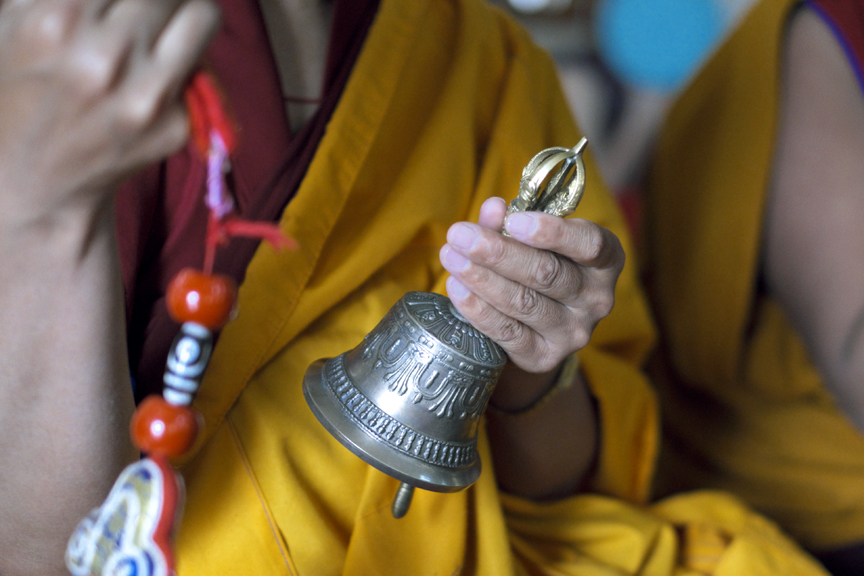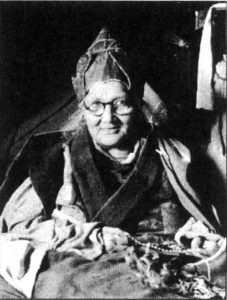The Power of Prayer
Buddhists believe that prayers can help relieve suffering and overcome obstacles. In Tibetan culture, it is common to request Buddhist nuns and monks to say prayers and perform spiritual ceremonies. The prayers and pujas can be for many purposes such as good health, long life, success, and to ease the journey of someone who has passed away.
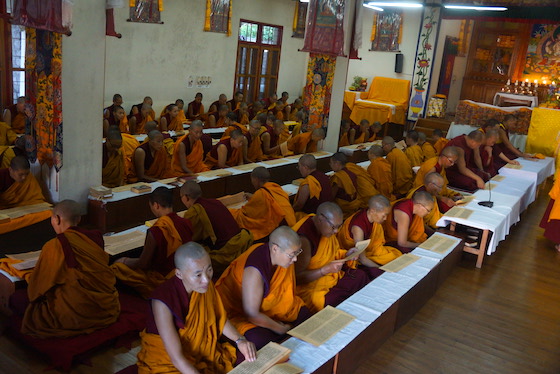
Tibetan Buddhist nuns praying at Dolma Ling Nunnery.
In challenging times when we feel helpless, sponsoring prayers and pujas brings comfort to the giver and the person receiving the blessings. Tibetans recite mantras and prayers to purify the mind, deal with negative emotions, increase merit, and invite help from the Buddha and various enlightened beings.
What is a puja?
Puja is a Sanskrit term meaning offering or worship. In Tibetan Buddhism, the word puja is used to describe a variety of ritual performances and prayers typically conducted in temples, nunneries, or monasteries.
The specific actions vary depending on the tradition but generally include chanting and reciting ritual texts to bring blessings, purify the mind, and cultivate merit. Pujas generally include offerings to show respect and reverence for Buddhas and bodhisattvas. These offerings include incense, light as butter lamps or candles, flowers, fruit, and water.
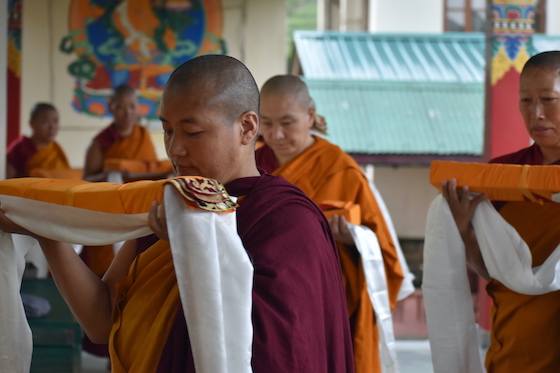
Tibetan Buddhist nuns at Shugsep Nunnery holding sacred texts as part of a puja.
How to Sponsor a Puja by Tibetan Buddhist Nuns
You don’t have to be a Buddhist to request prayers. You can ask the Tibetan Buddhist nuns in northern India to perform prayers and pujas on your behalf.
People around the world can sponsor pujas or prayers through our Tibetan Nuns Project website. You can sponsor prayers in honor of loved ones, friends, family members, or even pets who may be suffering from obstacles, ill health, or who have passed away.
When requesting a puja or prayers from the Tibetan Nuns Project please provide information about who the prayers are to be directed to and for what purpose. The funds given to the nuns to sponsor pujas are used to purchase supplies and also help to support the nunnery as a whole.
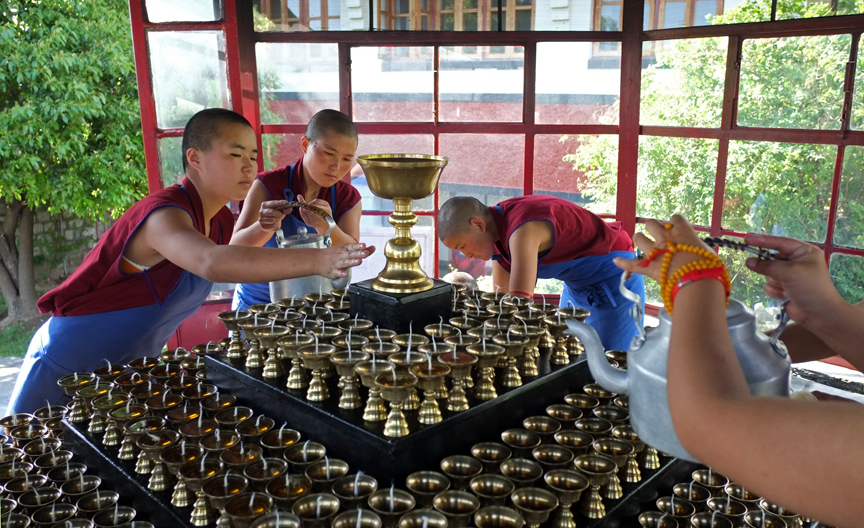
Tibetan Buddhist nuns at Dolma Ling Nunnery prepare hundreds of butter lamps for a special puja.
A gift of prayer is something very special. As soon as we receive your request for a puja, we will send you a thank you message by email. As soon as possible after that, the nuns will email you a confirmation note and receipt to let you know that the puja has been performed.
Types of Tibetan Buddhist Pujas by the Nuns
There are many different types of prayers or pujas to choose from, ranging from offering 100 butter lamps to the elaborate “21 Praises to Tara” which includes 100,000 recitations of the Tara prayer, renowned for removing obstacles and fulfilling wishes. Here are the descriptions. You can find all the pujas and costs listed here.
Butter Lamps Offering (Mar-me): Butter lamps are part of daily traditional Tibetan practice and are also lit for many occasions. It is common to offer butter lamps for those who are sick or have passed away (to light the path towards liberation). Butter lamps are also lit for happy occasions like birthdays and marriages, or to aid with focus and meditation. Tibetans light butter lamps on sacred days in the Tibetan Buddhist calendar, such as the 10th, 15th and 25th day of each lunar month, as well as during the holy month of Saga Dawa. This offering will provide fuel to light 100 butter lamps, which is usually butter or oil.
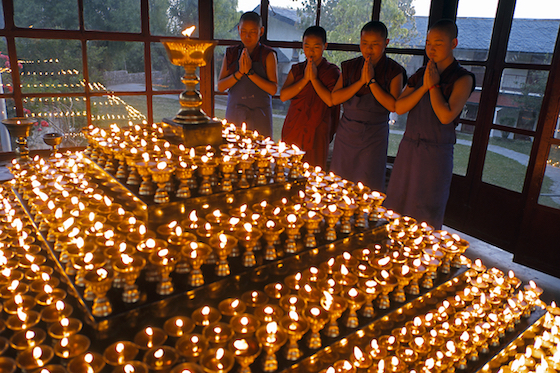
Tibetan nuns at Dolma Ling Nunnery offer butter lamps as part of a healing puja. Photo by Brian Harris
Medicine Buddha (Men-la): This puja aids in healing physical, mental, and emotional ailments. It invokes the wisdom and blessings of the Medicine Buddha (Sang-gyay Men-la) and can also enhance and support your work if you are a medical practitioner.
Offering to Tara (Drol-chok): Tara is known as a protector who relieves physical, emotional, and spiritual suffering. This elaborate offering involves creating ritual cakes called tormas and the use of musical instruments. This puja is particularly effective in removing obstacles and fulfilling wishes.
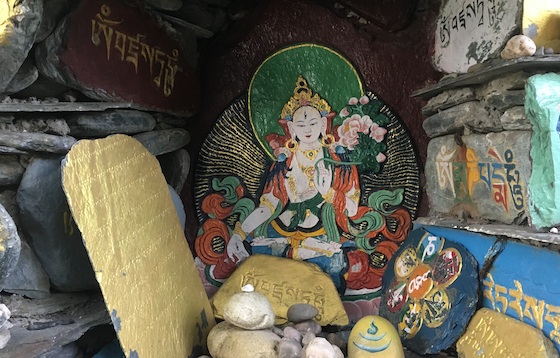
White Tara surrounded by mani stones. Tara is especially revered in Tibetan Buddhism and is known as the “mother of liberation”. Photo courtesy of Heather Wardle
Twenty-One Praises to Tara (Dolma-bum): Tara is believed to be a Bodhisattva of compassion and a protector who relieves physical, emotional, and spiritual suffering. Each of the twenty-one emanations of Tara has her own name, special attributes, and a specific mantra with which she is associated, offering protection from various types of fears, harm, and calamities. The Praises to the 21 Taras puja protects you from fear and dangers and is renowned for removing obstacles and fulfilling wishes, especially wishes on the spiritual path. This puja includes 100,000 recitations of the “Twenty-one Praises to Tara” prayer. Due to the time-intensive nature of this prayer, it will take an average of two weeks to complete.
Here is a sound recording made by Olivier Adam of the nuns chanting the Tara Puja. Can’t hear it? Click here and scroll down.
Long Life Ritual (Nam-gyal Tse-chok): This is a prayer for longevity to the female deity, Nam-gyal-ma, one of the three buddhas of long life.
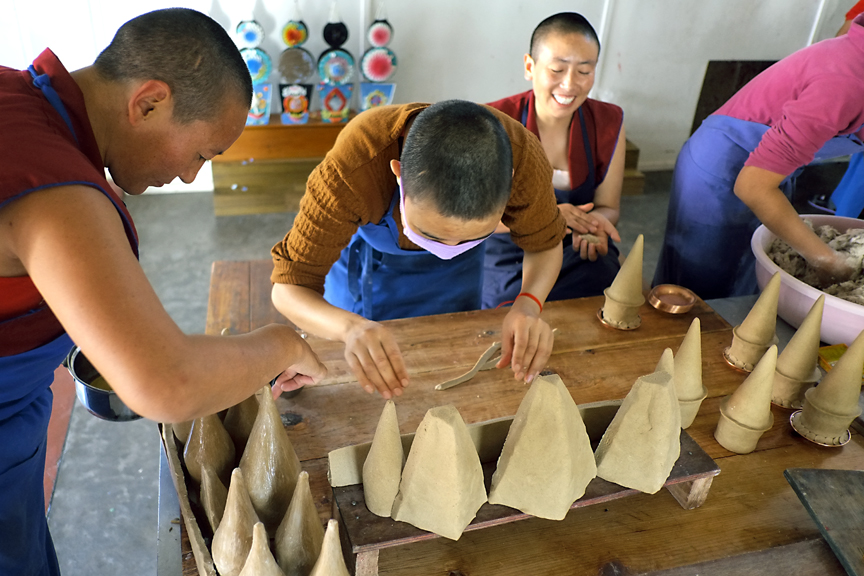
Tibetan Buddhist nuns prepare tormas for a puja. Tormas are figures made mostly of flour and butter used in tantric rituals or as offerings. Photo courtesy of Brian Harris.
Four Hundred Offerings (Gyab-zhi): Gyab-zhi is one of the most widely practiced ceremonies in Tibetan Buddhism. The ritual involves four sets of 100 offerings: 100 butter lamps to eradicate delusion; 100 ritual cakes called tormas to overcome desires; 100 human effigies made of dough to subdue the demon of death; and 100 tsa-tsa which are stamped clay votive images to overcome tainted aggregates. The intention of the Four Hundred Offerings is to aid in overcoming inauspiciousness, disease, untimely death, and challenging supernatural forces.

Tibetan Buddhist nun holding tormas. Photo by Olivier Adam copy
Three Pairs (Chak-sum): Chak-sum is an offering of three ritual cakes, or tormas: one to the protectors of the Buddha Dharma, another to local spirits, and a third to the suffering beings of the “Hungry Ghost Realm.” These offerings are intended to aid in the purification of negativities.
Cutting Through the Ego (Chöd – Simple): This puja aims at cutting through the hindrances or obscurations of self-cherishing thought and ignorance, the greatest obstacles on the path to enlightenment. The Chöd puja involves prayer, chanting, visualizations and the playing of Tibetan instruments such as the hand drum. It can also be effective for those who are severely ill. This puja is performed by the nuns at Shugsep Nunnery and Institute.
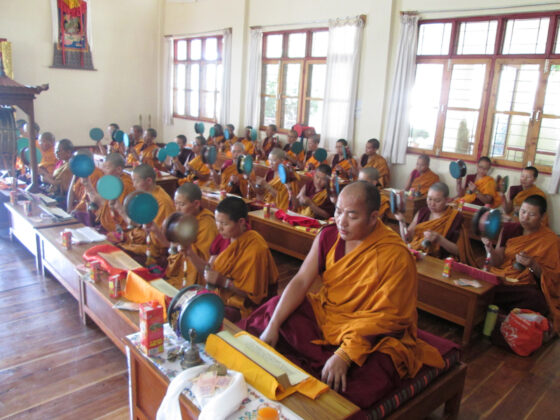
Chod practice at Shugsep Nunnery and Institute
Cutting Through Ego (Chöd – Elaborate with Tormas): The tantric practice of Chöd is effective for those who are severely ill. This elaborate version of Chöd (pronounced chö) involves the creation and offering of various ritual barley cakes called tormas. During the ritual, the nuns immerse themselves in chanting, music, prayer and visualizations. While reciting the Chöd rite the nuns are accompanied by the sound of several Tibetan instruments: the damaru or hand drum, the kangling, a reed instrument, and the large Chöd drum, which is larger than the hand drum. This puja is performed by the nuns at Shugsep Nunnery and Institute.
Gya-thong-pa & Sung-dhu: This puja involves reading the 800-verse Perfection of Wisdom Sutra and the Collection of Dharanis. It generates great merit and helps to overcome sickness and other obstacles.

